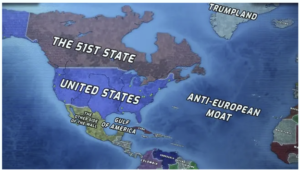My wife and I recently attended a concert performed by a Kenny Rogers imitator. He sang a lot of the old favorites. One brought back vivid memories because I used it when I taught negotiation to my electric utility clients. It was “The Gambler.” Here is the refrain:
You’ve got to know when to hold ’em
Know when to fold ’em
Know when to walk away
And know when to run
You never count your money
When you’re sittin’ at the table
There’ll be time enough for countin’
When the dealin’s done
The wisdom of these lyrics along with their brevity and easy memory make them powerful. I could never play poker because my face would give away my hand. The three key ideas here are to know the strength of your hand, understand the risks of playing cards with others, and how to avoid bad reactions to your success if you have any.
We have leadership today that seems brazen in comparison to the last four years, and the international game-stakes have risen to potentially catastrophic levels. You and I are watching this game play out in real time and wondering whether we are going to win or lose and the consequences. It is like riding in the back seat of a car going 100+ mph down on an icy road and wondering whether we are safe. We are all captive and a bit terrified.
So, it is not surprising that many are trying to sue the driver and take him off the road. We don’t like the apparent risks. But most of us know we have a strong hand and have been played for a fool for the past four years on the international stage with bad consequences.
However, we don’t really know what cards our adversaries are holding. We used to think of Russia as a powerhouse, but how can they be if the small country of Ukraine can keep them away from what seemed an overnight takeover? We have seen our continental neighbors threaten and then fold their hands when the new administration called their bluff.
My biggest concern is that we will count our money while still sittin’ at the table, in large part because the media needs to back off in their criticism and descriptions of how they see the hand being played. This is where I was taught to keep my mouth shut and neither confirm nor deny anything I was asked about our nuclear submarine capabilities.
We are playing a big hand on the world stage. We need to realize that the stakes are high and the chances for bad things to happen increases with the endless, cuttingly negative spin by our press.
We elected a world class gambler, and he wrote the book on negotiations long ago. His gamble is to fix our country’s egregious errors which have been identified by previous presidents Clinton and Obama. We must cut our massive 36 trillion-dollar deficit on which we pay 2.6 billion dollars each day, cutting wasteful government spending, and getting inflation under control. Prior administrations have said they would do these things and did not, which is why we are where we are today. Fixing it will take leadership, and the American people have voted for this change. So, lead, follow, or get out of the way, and let’s reclaim our winning position in the world.
This does also remind me of the old black and white movie, The Caine Mutiny, which explored the moral complexities of war and the fine line between loyalty and mutiny. What we should learn from all of this is that it is too early to decide how to draw the line between loyalty and mutiny … and that by trying to make the decision early, we are diminishing the likely good outcomes.
Give it some time … we will all learn where the line is at the right time.
And, as a bonus, here is an article posted to me by a friend:
The Lion
By: Judd Garrett
Objectivity is the Objective
February 2, 2025
In the 2002 movie Poolhall Junkies, actor Christopher Walken gives one of the most famous and iconic speeches of his career. He tells a group of pool hustlers,
“You got this lion. He’s the king of the jungle, huge mane out to here. He’s lying under a tree, in the middle of Africa. He’s so big, it’s so hot. He doesn’t want to move. Now the little lions come, they start messing with him. Biting his tail, biting his ears. He doesn’t do anything. The lioness starts messing with him. Coming over, making trouble. Still nothing. Now, the other animals notice this. They start to move in. The jackals; hyenas. They’re barking at him, laughing at him. They nip his toes and eat the food that’s in his domain. They do this; then they get closer and closer, bolder and bolder. Till one day, that lion gets up and tears the shit out of everybody. He runs like the wind and eats everything in his path. Cause every once in a while, the lion has to show the jackals, who he is.”
The United States is the lion; China and Russia are the hyenas; Hamas and ISIS are the jackals; every once in a while, the lion has to show these jackals, who he is. Far too long, whether it was by design (Obama) or incompetence (Biden), the United States has allowed the hyenas and the jackals to run wild, to do whatever they wanted to us with impunity. We were too scared to offend them. Too worried about being viewed as the bad guy. Yesterday, President Donald Trump ordered precision air strikes on the Senior ISIS leaders and terrorists in Somalia who were hiding in caves, threatening the United States and our allies. The strikes killed many of the terrorists without harming civilians. On X, President Trump tweeted to ISIS and any other terrorist groups who are targeting Americans, “WE WILL FIND YOU, AND WE WILL KILL YOU!” Donald Trump is showing the world who America is.
It’s about time that the United States of America acted like the United States of America. We have to show the world that we are the strongest, the most powerful nation on the planet. We won’t be messed with. We must demand their respect. We have allowed countries who are much smaller than us and weaker than us to push us around. The only way you can command respect is if you respect yourself. That’s the whole point of the Trump Presidency, about making America great again – to regain that respect internally and internationally. The importance of respect is the reason why the people on the left who want to destroy America continually trash America, continually hyper-focus on every single one of our sins and our misdeeds in the history of our country. Every other country has committed the sin of slavery. There are 20 million enslaved people in the world today throughout the Middle East, Asia, and Africa. But we are the only country in the world that must tear ourselves down over a sin we exorcised over 160 years ago. Most countries were forged through conquest, but they want America to feel we are an illegitimate country because of our origins. They do not want us to respect ourselves, because then no other country will respect us. And if they don’t respect us, they will be emboldened to do whatever they want to us. We will no longer be the lion.
After the October 7th attack on Israel, the Biden administration tried to convince Benjamin Netanyahu to not strike back and defend his country. He wanted Israel to just allow Islamic terrorists to kill 1,500 Israeli innocent women and children and capture hundreds more as hostages without doing anything back. He didn’t want to upset anyone. He didn’t want us to appear Islamophobic. That was the message we were sending out to the world. We won’t hit back. We want peace at all costs. Peace at any price always leads to war. The best way to ensure peace is for the United States to re-establish its power and respect worldwide. That is why Donald Trump is planning on annexing Greenland and taking control of the Panama Canal. The weakness of the Biden administration has emboldened China and Russia, causing them to exert more and more influence over those two geostrategic entities, which will further hurt our strength and respect around the world and make the world a more dangerous place.
Donald Trump just imposed a 25% tariff on goods coming from Mexico and Canada, and critics are outraged, complaining that we are hurting our closest allies. For far too long, these countries have allowed illegal immigrants from hostile nations to come across their border into the United States; they’ve turned a blind eye to the tons of fentanyl coming across their border, killing 100,000 of our citizens each year. They do not respect us. If they did, they wouldn’t allow that to happen to us. They are not our friends or allies. If they were, they would not have aided and abetted the invasion of our country of mass illegal aliens and massive amounts of deadly drugs. So, everyone who questions the tariffs because these countries claim to be our friends, remember, they are not our friends. They don’t have the right to claim to be our friends when they have never acted like our friends when they have systematically tried to destroy our country. That’s not friendship. That’s not even a geo-political ally. They are doing the work of our enemies.
Mexico and Canada are the little lions and the lioness, thinking they can mess with us because of a familial relationship. But when countries like China, Russia, and Iraq see how Mexico and Canada mess with us and take advantage of us, that emboldens them. They think they can do the same to us, just as the hyenas and the jackals do to the lion in Africa. For the last four years, we have been seen as weak, and now, because of Donald Trump, we are finally flexing our muscles. We are finally showing the world who the United States of America really is.




